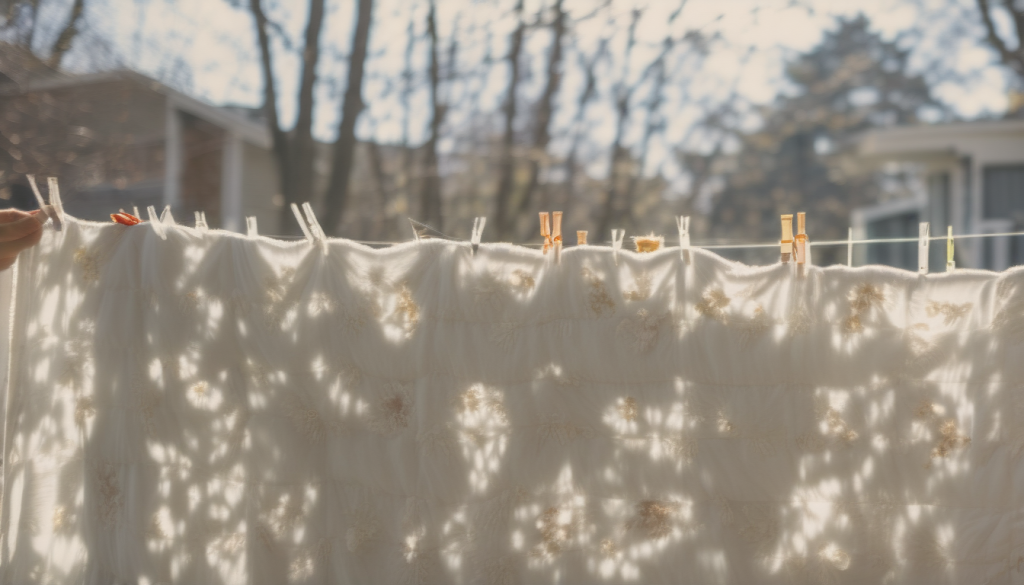Do you love snuggling under the warmth and comfort of a down-filled duvet on a cold winter night? As cozy and dreamy as our beds feel, down comforters require special care and handling to keep them clean, fluffy and long-lasting. Read this beginner’s guide to learn everything from deciphering care labels to pros and cons of home laundering to responsible ownership practices.
I. Introduction to Down Comforters
A. Definition and Function
- Down comforters are filled with the soft, fluffy underplumage from ducks and geese that grows beneath their exterior feathers. This natural fill power provides exceptional warmth and comfort.
- They are designed primarily to insulate and retain body heat while sleeping under home bedding, though smaller down throws can be used on sofas or chairs for extra warmth.
- The fill is held in place by a duvet cover or other fabric shell, usually with stitching or quilting to prevent shifting. This protects the delicate down.
B. Types of Down Fill
There are a few common categories:
- Goose down
- More expensive, higher fill power and durability
- Larger clusters, better loft and insulation
- Duck down
- Affordable alternative to goose down
- Smaller clusters, less efficient insulation
- Down blends
- Mix with feathers or synthetic fibers
- Reduces cost but impacts benefits
| Fill Material | Price | Benefits | Drawbacks |
|---|---|---|---|
| Goose Down | High | Great loft, maximum warmth | Expensive |
| Duck Down | Medium | Good loft and warmth | Lower durability |
| Down Blends | Low | Affordable, still decently warm | Less efficient insulation |
C. Benefits of Using Down Comforters
Compared to alternatives like polyester fills or wool blankets, key advantages of down include:
- Lightweight – Provides more warmth relative to weight
- Packable – Easily compresses into storage bags
- Breathable – Allows body moisture to dissipate
- Long-lasting – Can be used for 10+ years if cared for properly
That said, down does require special cleaning precautions and benefits from regular maintenance to maximize longevity and performance.
II. Understanding Care Labels and Instructions
A. Importance of Care Labels
Those pesky tags with confusing symbols and instructions actually provide essential cleaning guidelines. Make note of key details:
- Fabric composition – Indicates materials used and recommended care
- Cleaning codes – Defines what methods are safe to use
- Warnings – Specifies risks like color loss or fabric damage
Ignoring care tag advice can shorten lifespan or ruin your comforter over time.
B. Deciphering Care Symbols
Common symbols to understand:
- Washing machine tub = Machine washable
- Water waves = Recommended water temperature
- Square with circle inside = Delicate cycle
- Triangle = Do not bleach
C. Interpreting “Dry Clean Only” Labels
- This strictly prohibits home laundering to prevent damage, excessive shrinkage, color loss or other risks indicated.
- However, “dry clean” does not automatically mean professionally done. See next section for comparison.
- Always follow this guidance for down-filled items unless care tag specifically says washing machine is safe.
III. Dry Cleaning vs. Home Laundering
A. Pros and Cons of Dry Cleaning
| Dry Cleaning Pros | Dry Cleaning Cons |
|---|---|
| Done by professionals with right solvents and equipment | More costly, inconvenient for frequent cleaning |
| Better for delicates like down with “dry clean only” labels | Still uses harsh chemicals in most cases |
| Prevents color loss, material damage, shrinkage | Some environmental impact |
B. Risks of Improper Home Laundering
Despite some modern advances allowing home washing of certain down items, risks include:
- Excess agitation can damage filling and fabric
- Improper drying can reduce fill power, cause clumping
- Shrinkage, color loss, faster wear and tear
Bottom line: Follow care label guidance to determine if professional vs. home cleaning is required.
C. Impact on Comforter Longevity
Frequent washing, especially using the wrong methods, will degrade the down fill faster by:
- Stripping away beneficial lanolin oil coatings
- Breaking up clusters so they lose warming efficiency
- Reducing fill power (volume & insulation)
This shortens the usable lifespan. Gentler cleaning at longer intervals preserves quality.
IV. Essential Tools and Materials
A. Recommended Detergents
If home washing is approved for your down comforter, choose an ultra-gentle detergent like:
Avoid regular detergents or products with optical brighteners, enzymes, bleaches and dyes.
B. Gentle Stain Removers
For spot treating stains before washing, test mild solutions like:
- Dish soap
- Hydrogen peroxide
- Lemon juice
- Salt scrub
Trial on hidden area first to check for colorfastness.
C. Proper Drying Equipment
To restore maximum loft and prevent mildew risks, use:
- Large capacity front-load dryers
- Mesh drying bags
- Hangers and garment racks
- Tennis balls for agitation
Limit heat exposure to prevent breaking down oils.
V. Home Laundering Guidelines
Only attempt home washing if specifically noted safe for the material by manufacturer.
A. Preparing the Washing Machine
Before starting:
- Shake out all feather fill clumps
- Close zippers, fasten hooks, tie strings
- Use mesh bag for delicate items
- Set washer to cold, delicate cycle
Choose lower, slower spin speeds.
B. Washing Techniques for Down Comforters
Steps for the wash process:
- Select gentle detergent per guidelines above
- Use warm water setting, not exceeding 105°F
- Add comforter and allow to fully soak
- Let machine run through gentle wash/rinse
- Avoid forceful agitation like wringing
This keeps the delicate inner filling intact.
C. Drying Methods and Tips
- Move to dryer immediately after washing, do NOT let sit wet
- Use air or no heat delicate settings
- Add clean tennis balls to break up inner clumps
- For larger items, take to dry cleaner facility for commercial machine
Proper drying is key to regaining maximum loft and warmth.
VI. Spot Cleaning and Stain Removal

A. Addressing Common Stains
Trial spot treatments first. Most typical down comforter stains can be handled with gentle cleaners described in Section IV above.
| Type of Stain | Cleaning Solution Recommendations |
|---|---|
| Oils/grease marks | Dish soap, vinegar, salt scrub |
| Sweat/body oils | Hydrogen peroxide, lemon juice |
| Wine, juice, soda | Club soda/seltzer |
| Chocolate, makeup | Dish soap, hydrogen peroxide |
| Mud, dirt | Salt scrub, soft brush |
| Mold/mildew | Vinegar, lemon juice |
B. Precautions for Spot Cleaning
- Always test hidden section first
- Blot, don’t aggressively scrub
- Allow ample time for air drying
- Avoid overly wetting down fill
Vigorous rubbing can damage inner materials.
C. Professional Stain Removal Options
For severe, set-in stains, seek help from garment care specialists. Services may involve:
- Commercial cleaning solutions
- Steam/vacuum suction
- Extraction equipment
- Drying assistance
Get an upfront service quote before proceeding.
VII. Alternative Cleaning Methods
A. Steam Cleaning
Steam is an effective eco-friendly sanitation method suitable for many down items. Benefits vs. washing:
- Less agitation of delicate materials
- No chemical residue
- Deodorizes and freshens
- Safe for most fabrics
Use the delicates/wool setting, keep 6 inches away to prevent moisture damage.
B. Air Fluffing
Simply hanging outside on breezy days allows fresh airflow to lift and separate down clusters. Helps restore thickness lost from compression during storage or sleeping.
C. Sunlight and Fresh Air Exposure
Rotating beddings placement allows sunlight to naturally deodorize and sanitize. Avoid direct sun which could fade colors – use shade. Rotate with indoor storage to prevent dust and dirt buildup outside.
VIII. Regular Maintenance Practices
A. Fluffing and Shaking
Gently fluff by hand every so often, particularly after removing from storage. Shake up and pat out any inner clumps or flat spots from weight compression. Filling should feel evenly distributed wall to wall after a few minutes of easy manipulation.
B. Storage Recommendations
- Store flat if possible – folding creates creases
- Use breathable storage cases/bags
- Shake and rotate comforter orientation periodically while packed
- Refresh with a gentle surface steam before remaking bed
Improper storage flattens insulation capacity over time.
C. Seasonal Care Routines
Assess fill resilience at the start/end of each usage period:
Spring/Summer
- Freshen up after winter then store properly
- Vacuum seal for humidity control
Fall/Winter
- Air out from storage then fluff fill
- Check for clumping, shifting, durability
- Hand wash or dry clean every 2 years (max)
IX. Understanding Down Comforter Construction
A. Impact of Cleaning on Fill Power
The fill rating for down (and down alternative) refers to cubic inches per ounce of loft generated. Higher numbers equal better insulation from less material. Reasons why cleaning methods impact warming performance:
- Agitation can break up down clusters
- Heat, friction damage feather structure
- Strips away beneficial natural lanolin oils
Too much washing degrades fill power over time.
B. Effects on Fabric Integrity
The woven outer shell gives the fill shape and prevents poking through your sheets. Like down filling though, fabrics have limitations:
- Fiber wear weakens stitching durability
- Heat breakdown can shrink fabrics
- Holes, rips, tears appear after repeated use
Gentle care preserves shell life significantly.
C. Maintaining Quilted Patterns
Pretty designs aside, the stitch lines are vital to performance by:
- Securing inner fill distribution
- Allowing loft to recover
- Preventing thin spots
- Keeping fill from shifting
Thus it’s crucial to protect quilting integrity when cleaning.
X. Professional Cleaning Considerations
While home methods may work temporarily, eventually professional services help revitalize tired bedding.
A. Selecting a Reputable Cleaner
Ask service reps key questions like:
- What down products experience do you have?
- Do you use special detergents and equipment?
- Are drying assistance services included?
- What are your typical turnaround times?
Visit shop in person whenever possible.
B. Communicating Care Requirements
Provide any extra details upfront like:
- Known fabric composition
- Observed wear, holes, stains
- Special handling instructions
- Desired fill fluffing method
This allows them to cater service accordingly.
C. Post-Cleaning Inspection Tips
Upon return, thoroughly check for:
- Fabric discoloration
- Missing buttons, attachments
- New stains or odors
- Fill consistency and distribution
- Overall resiliency and fluff
Catch any return issues promptly.
XI. Addressing Allergen Concerns

A. Down Allergy Misconceptions
Contrary to popular belief, down itself does not cause allergies. Reactions associated with beddings are typically dust mite related. That said, steps to reduce risks include:
B. Hypoallergenic Options
- Encase mattresses/pillows in protective covers
- Wash bed linens frequently with hot water
- Choose synthetics for sensitive people
- Allergen-proof fabric treatments
C. Allergen-Reducing Practices
- Dry clean down 2-3 times per year
- Freeze items overnight to kill dust mites
- Store in vacuum compression bags
- Wash hands after touching down
Use common sense protection for those with sensitivities.
XII. Repair and Restoration Guidance
A. Identifying Repairable Issues
Look for fixable defects like:
- Small holes, torn seams
- Broken zippers, strings
- Missing buttons, loose attachments
- Filling clumps and shifts
Leave more complex structural damage to the pros.
B. Seeking Professional Restoration
For comforters with sentimental value damaged by:
- Pet accidents, large rips
- Fire, smoke, floods
- Removable mold, mildew
Specialized services can often salvage and refresh beddings. Ask for an honest repair assessment and cost estimate first.
C. DIY Repair Techniques
For responsible owners willing tackle basic mending tasks:
- Hand stitch smaller seam holes
- Patch tears with iron-on fabric
- Replace detached strings, buttons
- Redistribute shifted down filling
Use matching durable thread and fabric glue when warranted.
XIII. Environmental Impact of Cleaning Methods
A. Eco-Friendly Dry Cleaning Options
See if local shops offer:
- CO2 systems
- GreenEarth or other non-toxic solvents
- Wet cleaning methods
- Solar equipment upgrades
- Recycling of waste materials
Support progress to reduce environmental footprints.
B. Water and Energy Conservation Tips
When home washing:
- Wash full loads only
- Use cold water cycle
- Line dry instead of machine dry
- Look for detergent made from plants
Every small change helps.
C. Sustainable Care Practices
Additional things we can all do:
- Hand wash spot stains instead of full clean whenever possible
- Use items until no longer usable/repairable
- Donate unusable beddings to textile recycling centers
- Buy from manufacturers that share your eco-values
Voting with our wallets makes waves!
XIV. Consumer Rights and Labeling Regulations
A. Understanding Labeling Requirements
By law, all bedding products sold in the USA must meet:
- Federal quality standards
- Country of origin clear markings
- Fiber content and recycling details
- Cleaning guidance per care symbols
This protects shoppers and drives accountability.
B. Consumer Protection Resources
If purchasing imported or handmade beddings lacking proper tags, request written cleaning instructions. Reach out to agencies like:
- Federal Trade Commission
- Better Business Bureau
- State consumer protection offices
When issues arise around false advertising or defective items.
C. Legal Implications of Misleading Labels
Intentionally incorrect labeling around fiber types, safety data or country of origin can trigger lawsuits plus civil and criminal penalties. Cases may involve:
- Incidents of allergic reactions or injury
- Unfair competition complaints
- Merchandise quality disputes
Manufacturers are liable for harm from improper labeling.
XV. Conclusion and Final Recommendations
A. Summary of Best Practices
To keep down comforters clean, fluffy and working their magic for years to come:
- Reference care labels and comply fully
- Home wash very delicately if labels permit
- Dry clean every 2-3 years minimum otherwise
- Fluff and rotate fill during storage
- Address spots/stains promptly and properly
- Seek timely professional help when needed
Frequently Asked Questions
Q: How often should I clean my down comforter at home?
A: Check the care label, but delicate home washing every 2-3 years is typically safe if done gently on cold, with mild detergent. Frequent or intense washing degrades fill power.
Q: Why does my down comforter lose fluffiness over time?
A: Normal use compresses the fill around your body, reducing loft. Proper storage and regular fluffing helps restore warming performance. Dry cleaning revitalizes flattened beddings.
Q: Can I put a down comforter in the dryer?
A: Only if care tags specifically permit – use air or no heat delicate settings. For best results, commercial machine drying assists maximum fill relofting after washing beddings. Air drying risks moisture buildup.
Q: How do I wash down pillows?
A: Pillows require similar special care as down comforters. Always reference garment labels first. When home laundering, use cold water on the gentle/delicate cycle in washers, then air or low heat to prevent fill damage.
Q: What is the best way to store a down comforter?
A: After fluffing fill distribution, store flat in breathable, oversized cases. Vacuum compression bags also work well. Folding and tight spaces crush insulation capacity over time.
Q: Can you put a down comforter in a duvet cover?
A: Yes, that is exactly what a duvet cover is designed for! The protective shell helps preserve the down comforter through many cycles of use and cleaning. Just launder the cover more often while following care instructions for the hidden blanket itself as well.








